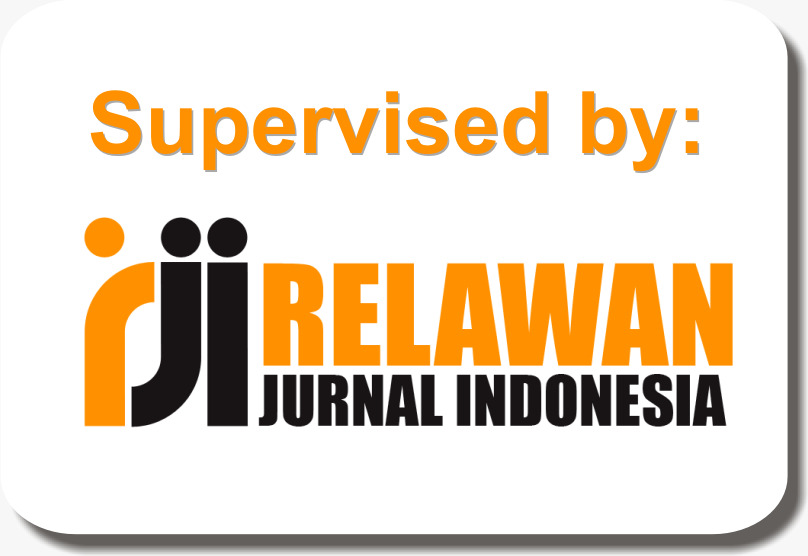Pengalaman Pengguna Pada Platform Magang : Pengembangan Dan Evaluasi Melalui Pengujian Berbasis UEQ
Abstract
Keywords
Full Text:
PDFReferences
Abdillah, F. (2024). Implementasi Clean Architecture Pada Pengembangan Sistem Informasi Koltitrace Farmcloud.
Alsolais, A. M. (2022). Development of a Web-Based Student Internship Portal for Students of Health Colleges. Fortune Journal of Health Sciences, 5(3), 451-460. doi:10.26502/fjhs.072
Dhandapani, S. (2016). Integration of user centered design and software development process. 2016 IEEE 7th Annual Information Technology, Electronics and Mobile Communication Conference (IEMCON), 1-5. doi:10.1109/IEMCON.2016.7746075
Familoni, B. T., & Babatunde, S. O. (2024). User experience (UX) design in medical products: theoretical foundations and development best practices. Engineering Science & Technology Journal, 5(3), 1125-1148. doi:10.51594/estj.v5i3.975
Febrianti, I., Tuffahati, J., Rifai, A., Affandi, R. H., Pradita, S., Akmalia, R., & Siahaan, A. (2023). Pengaruh Penggunaan Teknologi Informasi Dalam Manajemen Perencanaan Pendidikan Untuk Meningkatkan Efisiensi Pendidikan. Academy of Education Journal, 14(2), 506-522. doi:10.47200/aoej.v14i2.1763
Firdausia, F. (2024). Magang MBKM Sebagai Sarana Meningkatkan Adaptabilitas Karir Mahasiswa Teknik Mesin. Prosiding SEMDIKJAR (Seminar Nasional Pendidikan dan Pembelajaran), 7, 42-54. doi:10.29407/280adr33
Freitas, O., Delerue-Matos, C., & Ramalhosa, M. J. (2024). The Importance of Internships in Corporations for Student Motivation and Competency Development. ICERI2024 Proceedings, 3718-3722. doi:10.21125/iceri.2024.0948
Güncan, D., & Onay Durdu, P. (2021). A user‐centered behavioral software development model. Journal of Software: Evolution and Process, 33(2), e2274. doi:10.1002/smr.2274
Hendrawan, B., Novianto, R. A., & Sahara, S. (2024). Development of Website-Based Information System to Facilitate Students in Finding Internship Opportunities. International Journal Software Engineering and Computer Science (IJSECS), 4(2), 595-603. doi:10.35870/ijsecs.v4i2.2561
Hutabarat, R. S., & Sudaryana, K. (2024). User-Centered Design pada User Interface (UI)/User Experience (UX) Prototyping Aplikasi E-Commerce. Jurnal Penelitian Teknologi Informasi dan Sains, 2(4), 89-99. doi:10.54066/jptis.v2i4.2781
Ibrahim, M., Nasir, J., Komarudin, A., Maulana, A., & Akbar, M. H. (2023). Integrasi Kecerdasan Buatan dalam Desain Aplikasi Seluler: Peningkatkan Pengalaman Pengguna di Era Ekonomi Digital. Nusantara Computer and Design Review, 1(1), 31-39. doi:10.55732/ncdr.v1i1.1091
Jongmans, E., Jeannot, F., Liang, L., & Dampérat, M. (2022). Impact of website visual design on user experience and website evaluation: the sequential mediating roles of usability and pleasure. Journal of Marketing Management, 38(17-18), 2078-2113. doi:10.1080/0267257X.2022.2085315
Kapoor, A., & Gardner-McCune, C. (2019). Understanding CS undergraduate students' professional development through the lens of internship experiences. Proceedings of the 50th ACM Technical Symposium on Computer Science Education, 852-858. doi:10.1145/3287324.3287408
Khan, B. H. (2005). Managing e-learning: Design, delivery, implementation, and evaluation: IGI Global.
Kholik, A., Soegiarto, A., & Sari, W. P. (2024). Strategi komunikasi visual dalam user interface (ui) dan user experience (ux) untuk membangun kepuasan pengguna. TUTURAN: Jurnal Ilmu Komunikasi, Sosial dan Humaniora, 2(4), 335-344. doi:10.47861/tuturan.v2i4.1358
Lowdermilk, T. (2013). User-centered design: a developer's guide to building user-friendly applications: O'Reilly Media, Inc.
Mamakou, X. J., Zaharias, P., & Milesi, M. (2023). Measuring customer satisfaction in electronic commerce: The impact of e-service quality and user experience. International Journal of Quality & Reliability Management, 41(3), 915-943. doi:10.1108/IJQRM-07-2021-0215
Mao, J.-Y., Vredenburg, K., Smith, P. W., & Carey, T. (2005). The state of user-centered design practice. Communications of the ACM, 48(3), 105-109.
Miller, H., Miller Jr, B. R., & Spoelstra, J. (2021). A sustainability internship program: strategies for creating student stewards for sustainability. International Journal of Sustainability in Higher Education, 22(5), 1022-1037. doi:10.1108/IJSHE-08-2020-0314
Nwaimo, C. S., Adegbola, A. E., & Adegbola, M. D. (2024). Data-driven strategies for enhancing user engagement in digital platforms. International Journal of Management & Entrepreneurship Research, 6(6), 1854-1868. doi:10.1109/SAI.2014.6918172
Orlin, F. A., & Tandyonomanu, D. (2025). PENGARUH PENGALAMAN ESTETIKA VISUAL TERHADAP PURCHASE INTENTION PADA CAFÉ KAVLING DPR SIDOARJO. The Commercium, 9(1), 550-561. doi:10.26740/tc.v9i1.66217
Petcharat, W., & Sutthirak, T. (2024). Enhancing the Efficiency of Internship Management through the Implementation of Progressive Web App. International Journal of Interactive Mobile Technologies, 18(22). doi:10.30574/wjarr.2024.23.3.2633
Pratama, A., Faroqi, A., & Mandyartha, E. P. (2022). Evaluation of User Experience in Integrated Learning Information Systems Using User Experience Questionnaire (UEQ). Journal of Information Systems and Informatics, 4(4), 1019-1029. doi:10.51519/journalisi.v4i4.394
Rachman, A., Saputra, Y. A. D., Hafidz, M., Sugiman, Z. A. I., & Sahria, Y. (2024). Perancangan Ui/Ux Aplikasi Integrasi Teknologi Finansial" Fihub" Menggunakan Metode User-Centered Design. Jurnal Informatika dan Teknik Elektro Terapan, 12(1). doi:10.23960/jitet.v12i1.3884
Rahi, S., Ghani, M. A., & Ngah, A. H. (2020). Factors propelling the adoption of internet banking: the role of e-customer service, website design, brand image and customer satisfaction. International Journal of Business Information Systems, 33(4), 549-569. doi:10.1504/IJBIS.2020.105870
Sahu, S. K., & Ranganathan, S. (2025). Navigating Usability and User Experience in a Multi-Platform World With Agile Methodology. In Navigating Usability and User Experience in a Multi-Platform World (pp. 49-84): IGI Global.
Schrepp, M. (2015). User Experience Questionnaire Handbook.
Solecha, K., Irnawati, O., & Arifin, Y. T. (2024). Evaluasi Aplikasi Penerimaan Siswa Baru (PENEBAR) TK. Anak Bangsa Menggunakan User Experience Questionnaire (UEQ). Jurnal Infortech, 6(2), 113-118. doi:10.31294/infortech.v6i2.23551
Somasundaram, R., Chandra, S., Tamilarasu, J., Kinagi, A. M., & Naveen, S. (2025). Human Resource Development (HRD) Strategies for Emerging Entrepreneurship: Leveraging UX Design for Sustainable Digital Growth. In Navigating Usability and User Experience in a Multi-Platform World (pp. 221-248): IGI Global.
Stige, Å., Zamani, E. D., Mikalef, P., & Zhu, Y. (2024). Artificial intelligence (AI) for user experience (UX) design: a systematic literature review and future research agenda. Information Technology & People, 37(6), 2324-2352. doi:10.1108/ITP-07-2022-0519
Vetrivel, S., Sowmiya, K., Sabareeshwari, V., & Arun, V. (2024). Navigating the Digital Economy: The Crucial Role of Human-Computer Interaction. In Social Reflections of Human-Computer Interaction in Education, Management, and Economics (pp. 184-216): IGI Global.
Widyowaty, D. S., Ghozali, A. Z., & Kusbianto, M. r. (2025). Pengembangan Sistem Informasi Perjanjian Kinerja untuk Menunjang Manajemen Pendidikan Tinggi di IAIN Palangka Raya. Generation Journal, 9(1), 20-29.
Wulandari, O., & Tohir, A. (2024). Penggunaan Learning Management System (Lms) Dalam Meningkatkan Kualitas Pembelajaran Daring Di Perguruan Tinggi. Jurnal Review Pendidikan Dan Pengajaran (JRPP), 7(3), 10490-10496. doi:10.31004/jrpp.v7i3.31682
Zahidi, Z., Lim, Y. P., & Woods, P. C. (2014). Understanding the user experience (UX) factors that influence user satisfaction in digital culture heritage online collections for non-expert users. 2014 Science and Information Conference, 57-63. doi:10.1109/SAI.2014.6918172
Zhao, J. (2022). Strategies that Improve UX (User Experience) Design Through Product Innovation: Walden University.
DOI: http://dx.doi.org/10.30646/sinus.v23i2.928
Refbacks
- There are currently no refbacks.
STMIK Sinar Nusantara
KH Samanhudi 84 - 86 Street, Laweyan Surakarta, Central Java, Indonesia
Postal Code: 57142, Phone & Fax: +62 271 716 500
Email: ejurnal @ sinus.ac.id | https://p3m.sinus.ac.id/jurnal/e-jurnal_SINUS/
ISSN: 1693-1173 (print) | 2548-4028 (online)

This work is licensed under a Creative Commons Attribution-NonCommercial-ShareAlike 4.0 International License.















